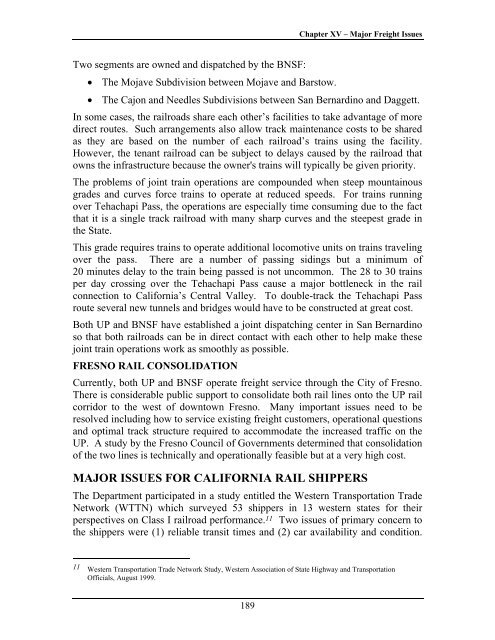California State Rail Plan 2005-06 to 2015-16
California State Rail Plan 2005-06 to 2015-16
California State Rail Plan 2005-06 to 2015-16
Create successful ePaper yourself
Turn your PDF publications into a flip-book with our unique Google optimized e-Paper software.
Chapter XV – Major Freight Issues<br />
Two segments are owned and dispatched by the BNSF:<br />
• The Mojave Subdivision between Mojave and Bars<strong>to</strong>w.<br />
• The Cajon and Needles Subdivisions between San Bernardino and Daggett.<br />
In some cases, the railroads share each other’s facilities <strong>to</strong> take advantage of more<br />
direct routes. Such arrangements also allow track maintenance costs <strong>to</strong> be shared<br />
as they are based on the number of each railroad’s trains using the facility.<br />
However, the tenant railroad can be subject <strong>to</strong> delays caused by the railroad that<br />
owns the infrastructure because the owner's trains will typically be given priority.<br />
The problems of joint train operations are compounded when steep mountainous<br />
grades and curves force trains <strong>to</strong> operate at reduced speeds. For trains running<br />
over Tehachapi Pass, the operations are especially time consuming due <strong>to</strong> the fact<br />
that it is a single track railroad with many sharp curves and the steepest grade in<br />
the <strong>State</strong>.<br />
This grade requires trains <strong>to</strong> operate additional locomotive units on trains traveling<br />
over the pass. There are a number of passing sidings but a minimum of<br />
20 minutes delay <strong>to</strong> the train being passed is not uncommon. The 28 <strong>to</strong> 30 trains<br />
per day crossing over the Tehachapi Pass cause a major bottleneck in the rail<br />
connection <strong>to</strong> <strong>California</strong>’s Central Valley. To double-track the Tehachapi Pass<br />
route several new tunnels and bridges would have <strong>to</strong> be constructed at great cost.<br />
Both UP and BNSF have established a joint dispatching center in San Bernardino<br />
so that both railroads can be in direct contact with each other <strong>to</strong> help make these<br />
joint train operations work as smoothly as possible.<br />
FRESNO RAIL CONSOLIDATION<br />
Currently, both UP and BNSF operate freight service through the City of Fresno.<br />
There is considerable public support <strong>to</strong> consolidate both rail lines on<strong>to</strong> the UP rail<br />
corridor <strong>to</strong> the west of down<strong>to</strong>wn Fresno. Many important issues need <strong>to</strong> be<br />
resolved including how <strong>to</strong> service existing freight cus<strong>to</strong>mers, operational questions<br />
and optimal track structure required <strong>to</strong> accommodate the increased traffic on the<br />
UP. A study by the Fresno Council of Governments determined that consolidation<br />
of the two lines is technically and operationally feasible but at a very high cost.<br />
MAJOR ISSUES FOR CALIFORNIA RAIL SHIPPERS<br />
The Department participated in a study entitled the Western Transportation Trade<br />
Network (WTTN) which surveyed 53 shippers in 13 western states for their<br />
perspectives on Class I railroad performance. 11 Two issues of primary concern <strong>to</strong><br />
the shippers were (1) reliable transit times and (2) car availability and condition.<br />
11 Western Transportation Trade Network Study, Western Association of <strong>State</strong> Highway and Transportation<br />
Officials, August 1999.<br />
189













